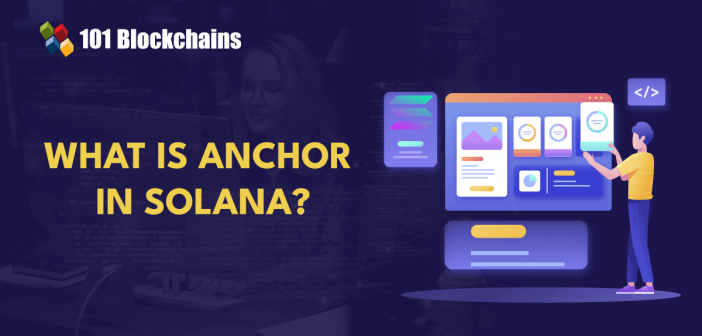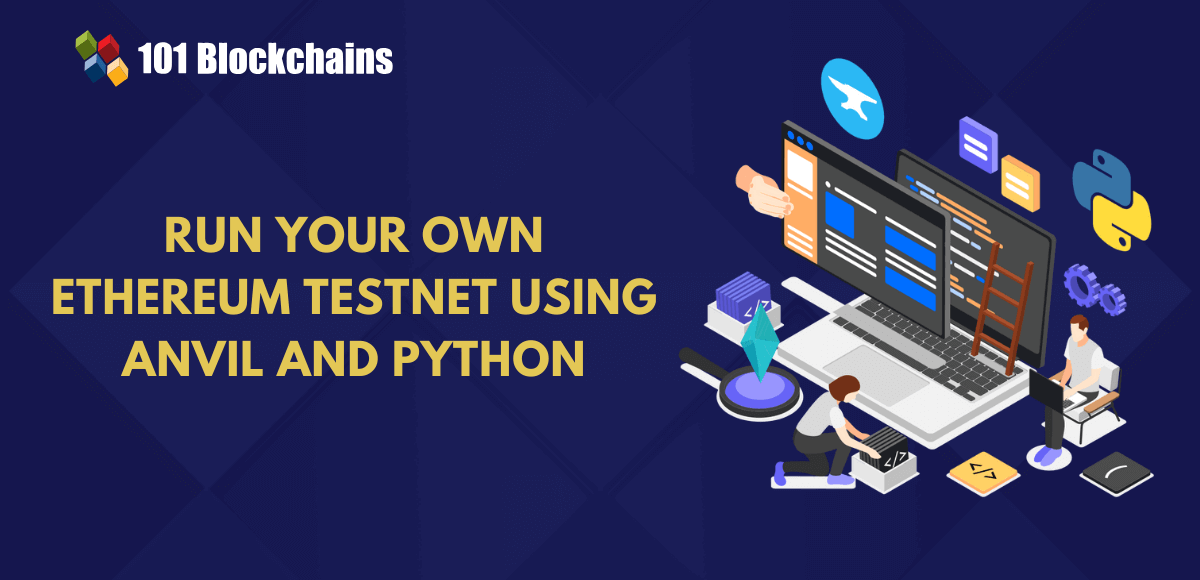The popularity of Solana has been increasing by exponential margins in recent times. It is a trusted alternative to Ethereum for solving problems with scalability and interoperability. Solana includes multiple components, and solana developers could capitalize on benefits of Solana by using the recommended tools. You are here seeking a Solana anchor tutorial because you know that it is an important tool for Solana development.
Just like Solidity helps in creating smart contracts on Ethereum and other EVM-compatible programs, Anchor helps in developing Solana ‘programs’ or alternatives to smart contracts. As the popularity of Solana grows, it is reasonable to expect a rise in demand for information about Anchor and its capabilities. Let us reflect on some of the most important details about Anchor and how to use it for Solana development.
Build your identity as a certified blockchain expert with 101 Blockchains’ Blockchain Certifications designed to provide enhanced career prospects.
What is Anchor?
The first thing you must learn about Anchor in Solana is the definition of the term. It is a framework for Sealevel runtime in Solana that offers a broad range of convenient developer tools to create smart contracts. On the other hand, a simpler answer to “What is the Anchor in Solana?” would paint it as a framework that helps in faster development of secure smart contracts on Solana blockchain. Anchor can help in building programs or smart contracts quickly with the facility of writing different boilerplate codes for custom requirements. For example, you can find a boilerplate for instruction data and deserialization of accounts with Anchor.
Another noticeable aspect of Anchor programming in Solana is the assurance of security. Anchor helps in building secure smart contracts with ease as it can manage different types of security checks for your projects. Furthermore, Anchor also helps users by providing subtle definitions for additional checks alongside isolating the checks from the business logic in the programs. Anchor ensures that you don’t have to deal with the complex aspects of raw Solana programs. On the contrary, you could spend more time on refining the product.
Enroll now in the Solana Development Course to understand the workings of the Anchor framework, Solana Program Library, and Solana tokens.
What are the Important Prerequisites Required to Learn the Use of Anchor?
Before you seek the ideal resources to install Anchor in Solana, you must know the important prerequisites for using Anchor in Solana. You must learn the fundamentals of Rust. Interestingly, you don’t need advanced knowledge of Rust programming to write programs in Anchor. On the other hand, you cannot ignore the importance of your knowledge of Solana. You must learn the important concepts related to programming on Solana before you begin using Anchor.
-
Memory on Solana
The high-level perspective suggests that memory in a Solana cluster is similar to a monolithic heap of data. Smart contracts or programs on Solana could access their dedicated portion from the heap. Programs could read any section of the universal heap. However, some programs could also try to write to a portion of the heap that is not theirs. In such cases, the Solana runtime would classify the transaction as a failure. It is also important to remember that Solana runtime can also make an exception in such cases when the programs want to increase the balance of an account.
Prior to diving deeper into Anchor programming, you must know that all state is present in the universal heap. It includes the SOL accounts of users, memory used by smart contracts, and the smart contracts. Every memory section has a program for managing it, which is known as the ‘owner.’
The memory section in Solana is known as an account, and some programs could have thousands of independent accounts. The heap is also the ideal place where programs live, and accounts storing programs are under the ownership of ‘BPFLoader’ program. It is a unique program for deploying and upgrading other Solana programs.
-
Transaction and Accounts
Another important prerequisite you must cover before a detailed Anchor introduction is the awareness of transactions and accounts in Solana. You can send transactions to ensure that a Solana can read and write data. Solana programs offer endpoints that you can call through transactions.
The function signature would take two arguments for calling endpoints. First of all, you have the accounts that the program can read and write to during the transaction. Another argument in the transactions on Solana points to additional data that is specific to the function.
How Can You Install Anchor?
Since the primary focus of this Solana tutorial revolves around Anchor, let us turn our eyes towards the main framework in question here. You can explore other detailed guides on Solana to understand the different components and features of the revolutionary blockchain platform. One of the first things you must learn about Anchor is the step-by-step guide to install Anchor Solana framework with knowledge of important prerequisites.
You can start the process by installing Rust, followed by installing Solana. Subsequently, you have to run the ‘solana-keygen new’ command to create a pair of keys at the default location. Anchor would utilize the pair of keys for running the program tests. It is also important to install Yarn as it helps in installing the essential dependencies for Solana programs.
-
Use Anchor Version Manager
The Anchor version manager or AVM is the recommended resource for installing Anchor. Any Solana anchor tutorial would help you learn that Anchor version manager is the essential tool for utilizing multiple variants of anchor-cli. It would also need the same dependencies as required for building projects from source. You must also remember the uninstallation of the NPM package if it is installed. The ideal approach for using AVM is through Cargo. You should notice that the following command would replace the ‘anchor’ binary.
cargo install --git https://github.com/coral-xyz/anchor avm --locked --force
In the case of Linux, you may need additional dependencies in the event of failure of ‘cargo install.’ You can use the following command on Ubuntu for accessing AVM functionalities.
sudo apt-get update && sudo apt-get upgrade && sudo apt-get install -y pkg-config build-essential libudev-dev
Another important aspect of Anchor programming in Solana would draw your attention toward installation of latest version of CLI through the AVM. In addition, you must also set it to the version that you want to use, followed by verification of the installation by using the following commands.
avm install latest avm use latest anchor --version
You can also choose to install Anchor Solana framework by using pre-build binary on x86-64 Linux systems. Another trusted option for installing Anchor framework points at developing from source for other operating systems without relying on AVM.
Curious to understand the complete smart contract development lifecycle? Enroll now in the Smart Contracts Development Course
How Can You Start a Project on Anchor?
Without any delay, let us dive into the details of initializing a new project on Anchor framework. You can simply use the following command for initializing a new project.
anchor init <new-workspace-name>
The command helps in creating a new anchor workspace that is in the form of a folder. You can find different types of tiles in the anchor workspace folder. Here is an outline of the content of files in the Anchor workspace.
The ‘.anchor’ folder includes the recent program logs alongside a local ledger for testing purposes.
‘app’ folder is an empty folder that helps in holding the frontend when you utilize a monorepo.
‘tests’ folder includes the E2E tests and also includes a default file for testing the sample code.
The guides to Anchor programing would also focus on the ‘programs’ folder, which contains the programs or Solana smart contracts. In the initial stage, the folder would contain only one program with the same name as the new workspace. However, it could also include multiple programs.
Another important highlight in the anchor workspace points to the ‘migrations’ folder which helps in saving the deployment and migration scripts for programs.
Most important of all, you cannot complete an Anchor introduction without referring to the ‘Anchor.toml’ file. The file helps in configuring settings for your programs throughout the workspace. It works on configuration of the addresses of programs on localnet and a registry where you can push your program. The file also specifies the provider that you can use in your tests. In addition, the ‘Anchor.toml’ file also offers configuration for scripts that are executed by Anchor for users.
Start learning Blockchain with World’s first Blockchain Skill Paths with quality resources tailored by industry experts Now!
High-Level Overview of Anchor Programs
The best way to expand answers to “What is the Anchor in Solana?” would focus on a high-level overview of Anchor programs. You can find three distinct parts in an Anchor program such as the program module, accounts structs and ‘declare_id’ macro. The ‘program’ module helps in writing the business logic.
The accounts structs help in validation of accounts. Finally, the ‘declare_id’ macro supports the creation of an ‘ID’ field that offers storage for address of the Solana program. Anchor leverages the ‘ID’ for security tests, and it also supports other crates with accessibility to your program address.
What is the account Struct?
The Accounts struct is one of the crucial components in Anchor programming that helps you define the accounts expected by the instruction. In addition, the Accounts struct also serves as the ideal tool for defining the constraints that the related accounts must follow at all costs. You can achieve these functions by using two distinct variants of constructs, such as types and constraints.
The ‘Types’ in an Accounts struct would work with a specific use case. You can find detailed explanations for account types in the reference in Anchor documentation.
Account types can serve different functions, albeit with the lack of dynamism for managing all security checks for Solana programs. You can find two Anchor account types, such as UncheckedAccount and AccountInfo, which do not use any checks on the account passed in the argument. However, Anchor utilizes safety checks to ensure additional documentation without the need for additional checks.
What is the Program Module?
The program module is the most valuable aspect of a Solana Anchor tutorial, as it helps in definition of business logic. It helps in scripting functions that you can call with clients or other programs. The two most important aspects of a program module point to the context and instruction data.
Every endpoint function assumes the ‘Context’ type as the first argument. This context argument helps the endpoint function in accessing the accounts and program id of the executing program alongside the remaining accounts. The ‘remaining_accounts’ is a vector that includes all accounts passed into the instruction without being declared in the Accounts struct. It is useful in situations where your function must manage an uncertain number of accounts.
Your endpoint function might also require instruction data. You could add instruction data for Anchor programming in Solana by adding arguments to the function, following the context argument. Subsequently, Anchor would automatically deserialize the instruction data in the form of arguments.
What are Errors in Anchor Programs?
Another crucial aspect of a comprehensive Anchor introduction points at errors. You can come across two variants of errors in Anchor programs, such as non-anchor errors and AnchorErrors. Furthermore, you can also classify AnchorErrors into custom errors and anchor internal errors.
AnchorErrors could offer different types of information, such as error names and locations or numbers in the code where the anchor was thrown or accounts that violated the constraints. After throwing inside the program, you could access the error information in anchor clients just like the typescript client. The typescript client also adds up to the error information with essential details about the program in which the error popped up.
Start learning Blockchain with World’s first Blockchain Career Paths with quality resources tailored by industry experts Now!
Bottom Line
The introductory guide to Anchor shows that it is a simple and engaging framework for building Solana programs. One of the foremost advantages of Anchor programming revolves around the assurance of security and speed. It not only helps in faster smart contract development on Solana but also offers additional security checks.
You can install Anchor and get started immediately on Solana without any complexities by using the Anchor version manager. On top of it, you must also learn about the important components of Anchor programs, such as the program module, Accounts struct, and the ‘declare_id’ macro. Dive deeper into Solana basics to identify the uses of Anchor framework now.








